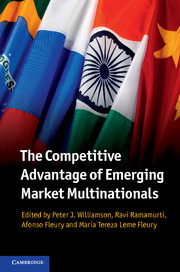Book contents
- Frontmatter
- Contents
- List of figures
- List of tables
- Notes on contributors
- Acknowledgements
- Introduction
- Part I Innovation and competitive advantage
- Commentaries on Part I
- Part II Value-chain configuration and competitive advantage
- Commentaries on Part II
- (II.i) How emerging market multinational enterprises upgrade capabilities using value-chain configuration in advanced economies
- (II.ii) Value-chain configurations of emerging country multinationals
- Part III Mergers and acquisitions and competitive advantage
- Commentaries on Part III
- References
- Index
(II.i) - How emerging market multinational enterprises upgrade capabilities using value-chain configuration in advanced economies
Published online by Cambridge University Press: 05 April 2013
- Frontmatter
- Contents
- List of figures
- List of tables
- Notes on contributors
- Acknowledgements
- Introduction
- Part I Innovation and competitive advantage
- Commentaries on Part I
- Part II Value-chain configuration and competitive advantage
- Commentaries on Part II
- (II.i) How emerging market multinational enterprises upgrade capabilities using value-chain configuration in advanced economies
- (II.ii) Value-chain configurations of emerging country multinationals
- Part III Mergers and acquisitions and competitive advantage
- Commentaries on Part III
- References
- Index
Summary
Introduction
Global value-chain configuration helps multinational companies improve their competitive advantage due to the integration within the firm of the comparative advantage of other countries and the competitive advantage of firms from other countries. Many studies of global supply chain take the view of developed market multinational enterprises (DMNEs) that tend to off-shore outsource production to developing countries in order to access the comparative advantage of low-cost labour (e.g. Lewin et al., 2009; see articles reviewed by Contractor et al., 2010, in the special issue on off-shore outsourcing). However, the emergence of emerging market multinational enterprises (EMNEs) challenges some of the assumptions of these studies because such firms are already operating in countries with low cost and, in principle, would not benefit from a similar global value-chain configuration. In contrast to DMNEs, EMNEs suffer from comparative disadvantages of operating in home countries with challenging institutions and without sophisticated resource intermediaries (Cuervo-Cazurra and Genc, 2008; Khanna and Palepu, 2010). Thus, the study of EMNEs can provide new insights on global value-chain configuration that previous studies of DMNEs may have overlooked.
In this commentary I analyse global value-chain configuration by EMNEs, specifically describing four strategies that these firms can use in advanced economies to upgrade their capabilities and solve their developing-country comparative disadvantages. I then illustrate the four strategies using the four country studies in this part of the book.
Information
- Type
- Chapter
- Information
- The Competitive Advantage of Emerging Market Multinationals , pp. 174 - 179Publisher: Cambridge University PressPrint publication year: 2013
Accessibility standard: Unknown
- 1
- Cited by
